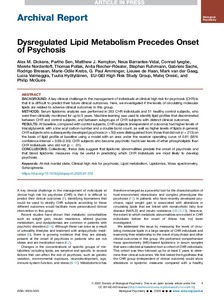Dysregulated lipid metabolism precedes onset of psychosis
Alex M Dickens; Partho Sen; Matthew J Kempton; Neus Barrantes-Vidal; Conrad Iyegbe; Merete Nordentoft; Thomas Pollak; Anita Riecher-Rössler; Stephan Ruhrmann; Gabriele Sachs; Rodrigo Bressan; Marie-Odile Krebs; G Paul Amminger; Lieuwe de Haan; Mark van der Gaag; Lucia Valmaggia; Tuulia Hyötyläinen; Matej Orešič; Philip McGuire
https://urn.fi/URN:NBN:fi-fe2021042826963
Tiivistelmä
Background
A key clinical challenge in the management of individuals at clinical high risk for psychosis (CHR) is that it is difficult to predict their future clinical outcomes. Here, we investigated if the levels of circulating molecular lipids are related to adverse clinical outcomes in this group.
Methods
Serum lipidomic analysis was performed in 263 CHR individuals and 51 healthy controls (HC), who were then clinically monitored for up to five years. Machine learning was used to identify lipid profiles that discriminated between CHR subjects and HC, and between subgroups of CHR subjects with distinct clinical outcomes.
Results
At baseline, compared to HC, CHR subjects (independent of outcome) had higher levels of triacylglycerols (TGs) with a low acyl carbon number and a double bond count, as well as higher levels of lipids in general. CHR subjects who subsequently developed psychosis (n=50) were distinguished from those that did not (n=213) on the basis of lipid profile at baseline, using a model with an AUC = 0.81 (95% CI = 0.69-0.93). CHR subjects who became psychotic had lower levels of ether phospholipids than CHR individuals who did not (p<0.01).
Conclusions
Collectively, these data suggest that lipidomic abnormalities predate the onset of psychosis, and that blood lipidomic measures may be useful in predicting which CHR individuals are most likely to develop psychosis.
Kokoelmat
- Rinnakkaistallenteet [27094]
